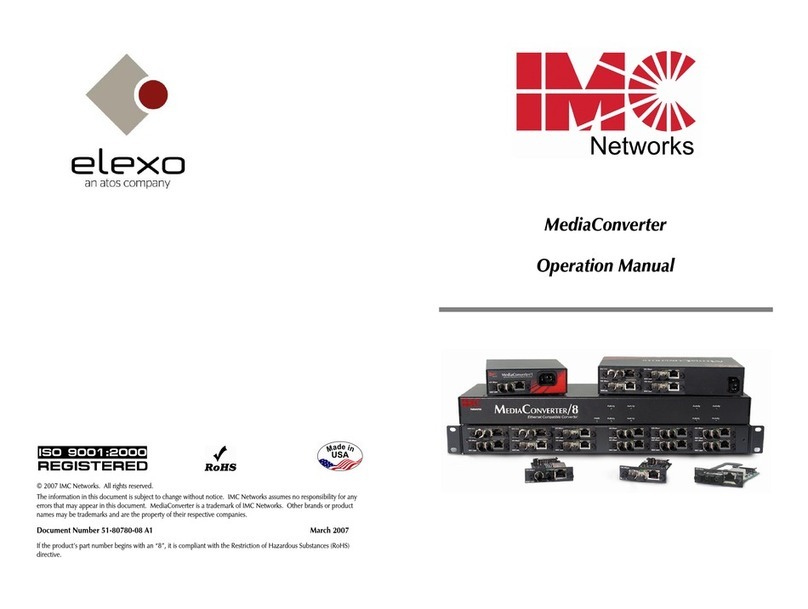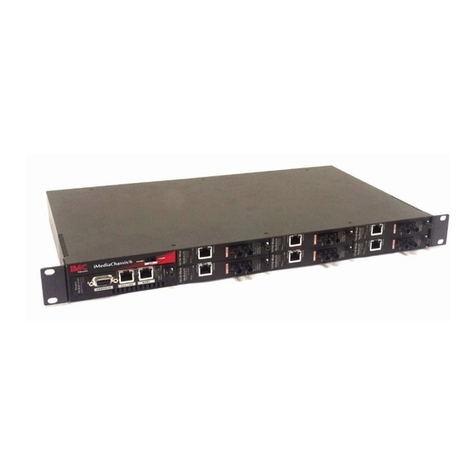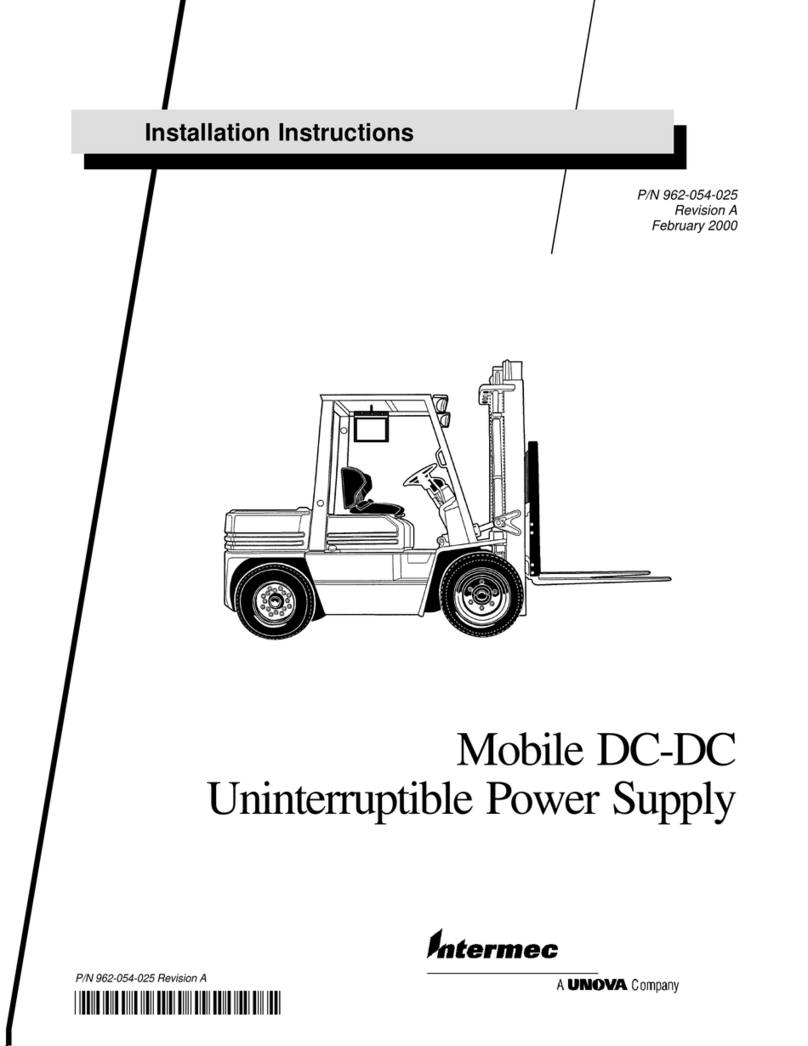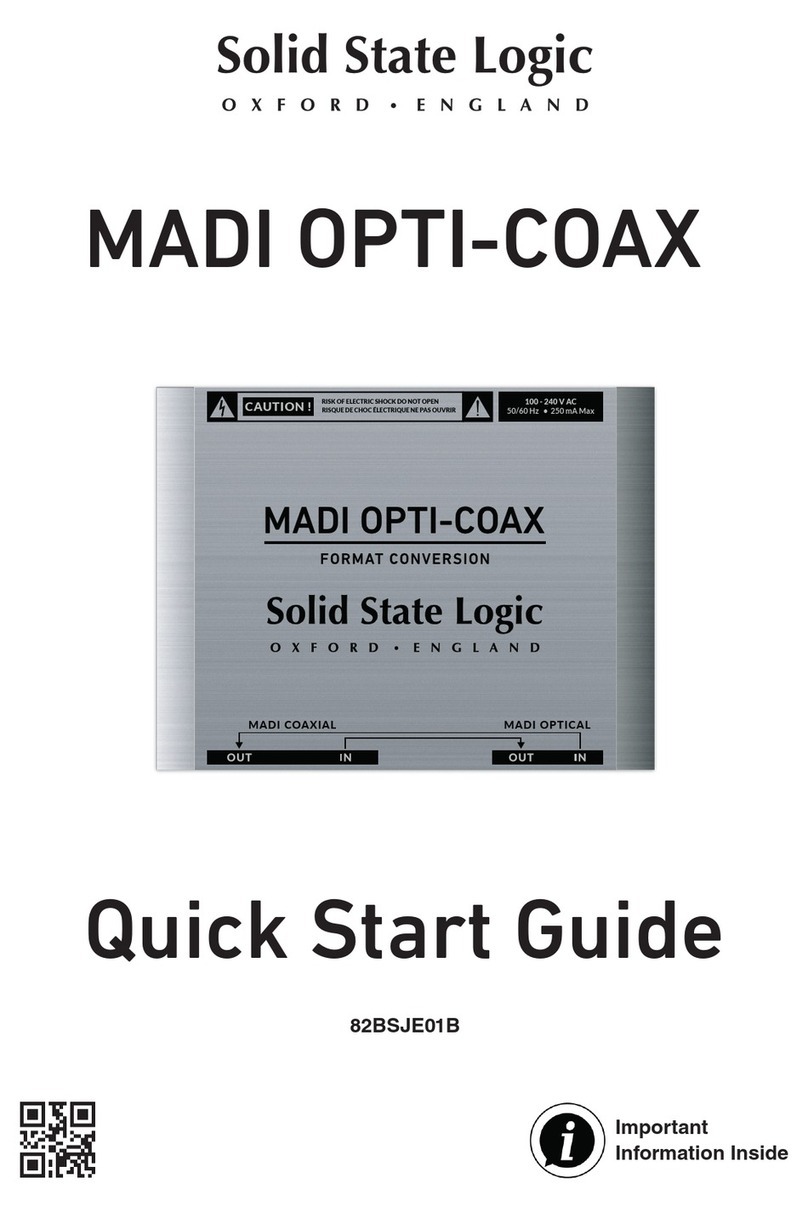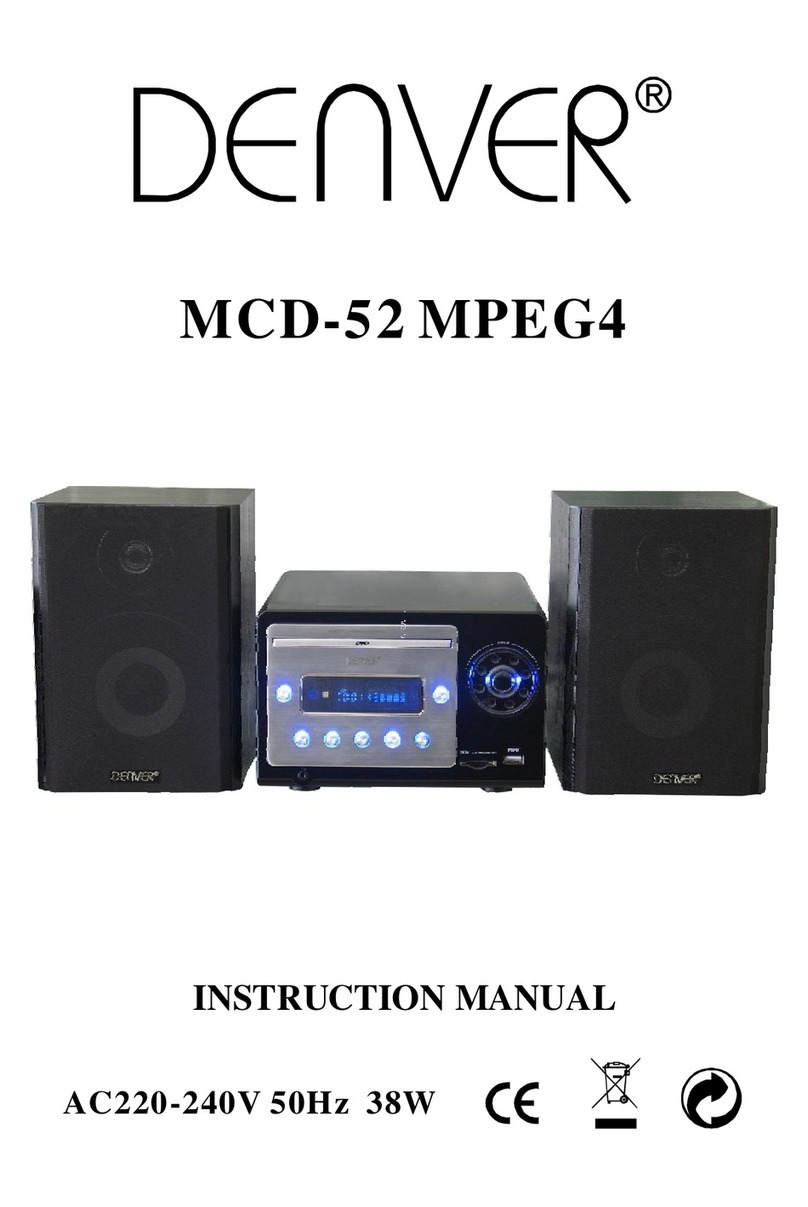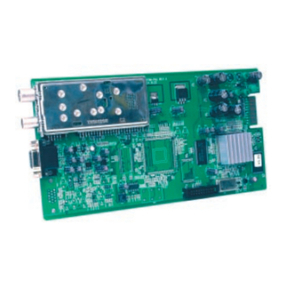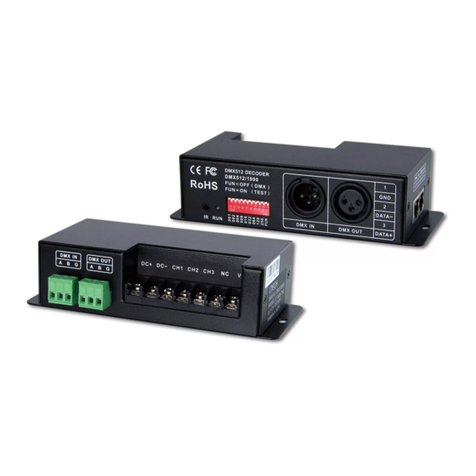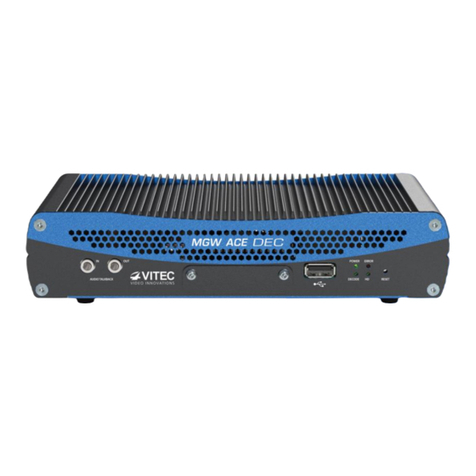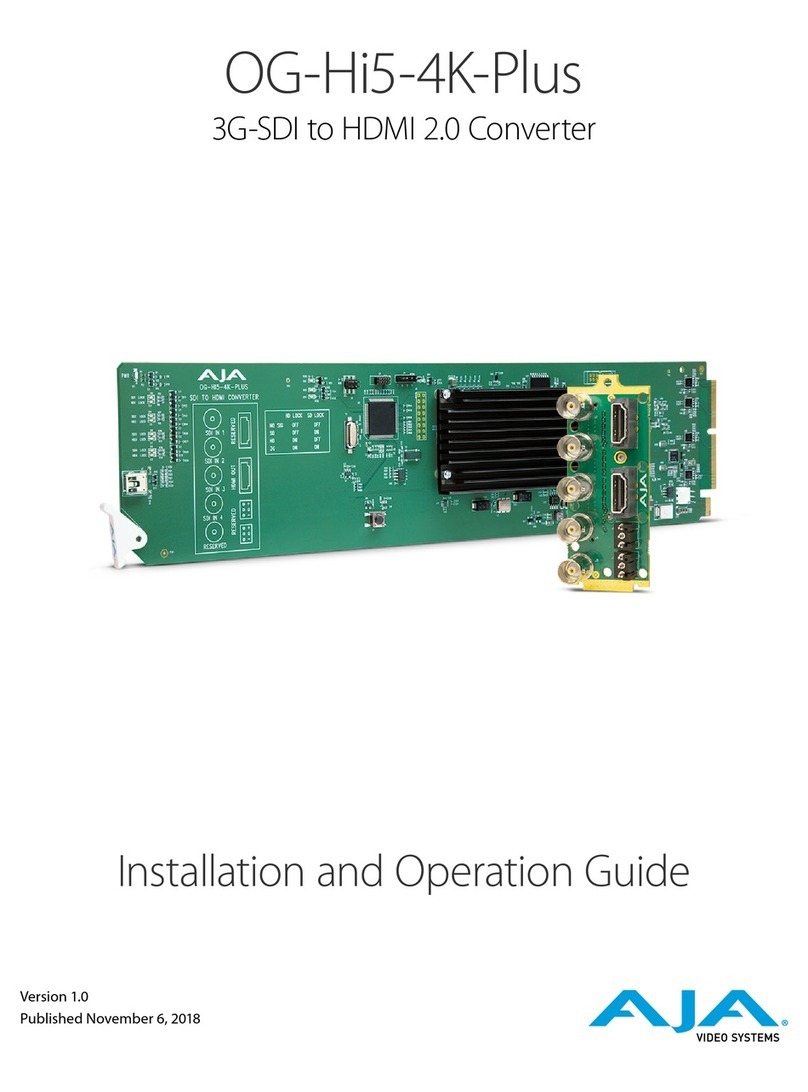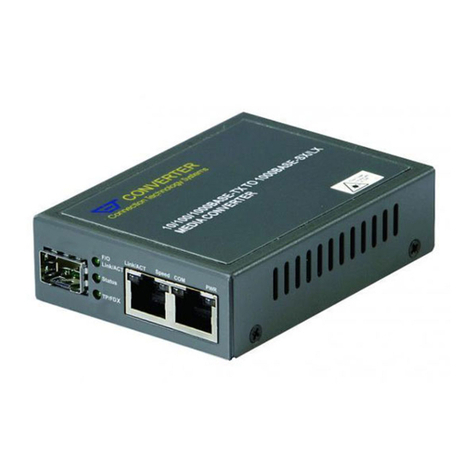IMC mcbasic 10/100 User manual

About McBasic 10/100
McBasic 10/100™ is a low-cost, standalone,
IEEE 802.3 single-conversion media
converter which converts between:
• 10Base-T twisted pair and
10Base-FL single- or multi-mode fiber
• 100Base-TX twisted pair and
100Base-SX multi-mode fiber
• 100Base-TX twisted pair and
100Base-FX single-mode fiber
McBasic 10/100 is a 1U high, standalone unit that includes diagnostic
LEDs for each port and an internal, universal (100/240 VAC) power supply.
McBasic 10/100
Installing McBasic 10/100
McBasic 10/100 comes ready to install. The only adjustments that may
need to be made after installation are:
•Configuring the unit for its mode of operation and other features.
•Setting the twisted pair port for a crossover workstation or
pass-through repeater/hub connection.
To install McBasic 10/100, first make sure that the unit is placed on a
suitable flat surface, leaving some space at the back of the unit to
accommodate the exhaust fan. Attach the cables between the
McBasic 10/100 and each device that will be interconnected, then plug
the unit into a reliable, filtered power source.
NOTE: All network cables must be connected for link LEDs to glow.
1
McBasic 10/100
by IMC Networks
Installation
Guide
QUICK START
Installation 1
Configuration 2
Modes of Operation 2
Crossover/Pass-Through 4
LED Indicators 5
Technical Support 5
Specifications 6
Warranty 6
Safety Certifications 7
Configuring McBasic 10/100
McBasic 10/100 features an 8-position DIP switch
for configuring the unit. This switch is accessed
through a cut-out in the bottom of the unit. After
configuring the switch, power down the unit and
then power up again for the DIP switch changes to
take effect. The following table provides simplified
definitions of the function of each switch. More
detailed information follows.
MCBASIC 10/100 MODES OF OPERATION
McBasic 10/100 features three possible “modes” of operation:
Auto-Negotiation/PNP mode,Force-10 mode and Force-100 mode.
McBasic 10/100 should be configured for one of these modes (factory default is
AN/PNP mode). Refer to pages 3-5 for information on Link Fault Detection.
•
Auto-Negotiation mode, also known as PNP, is the mode most ideally
suited for the McBasic 10/100. In this mode, the converter will
optimally and automatically configure for speed (10 or 100 Mbps)
depending on the capabilities of the end stations.
To enable Auto-Negotiation/PNP mode, set switch S6 to the ON
position, with switches S7 and S8 in the OFF position.
• In Force-10 mode, McBasic 10/100 permits the transmission of valid
10 Mbps traffic only. In this mode, the unit acts as a 10Base-T/
10Base-FL media converter; 100 Mbps signals are not accepted.
To enable Force-10 mode, set switch S7 and S8 to the ON position,
with switch S6 in the OFF position.
2
LFD S5 Link Fault Detection (Refer to page 4 for configuration OFF
instructions. Available only in Force modes)
PNP S6 Auto-Negotiation Mode (Plug-N-Play) ON
(Valid only when Force mode is disabled)
Force S7 Force Mode — Forces McBasic 10/100 to operate OFF
at 10 or 100 Mbps as determined by S8
100 or 10 S8 When ON, McBasic 10/100 operates at 10 Mbps OFF
When OFF, McBasic 10/100 operates at 100 Mbps
S8 is only valid in Force Mode, i.e. when S7 is ON
Note: S1 - S4 are factory configured — DO NOT CHANGE
MODE SWITCH FUNCTION DEFAULT
NOTE
McBasic 10/100 cannot be manually set for Half- or Full-Duplex. Duplex
is determined by the devices to which McBasic 10/100 is connected.

LINK FAULT DETECTION FEATURE
Link Fault Detection is only available when using Force-10 or Force-100
mode; it is not available in Auto-Negotiation mode. When LFD is
enabled and the input link is down at one interface to the McBasic
10/100, the transmitter output on that interface is turned off for about
425ms every 3.8 seconds (i.e. blinking). It applies to both network inter-
faces and to both data rates. If the link at the other interface to the
McBasic 10/100 is also down, there is no output. LFD causes the Link Up
indicator of the link partner to blink.
When McBasic 10/100 is in one of the Force modes, enable LFD by
setting S5 to the ON position. Disable LFD (default) by setting S5 to the
OFF position. In order for LFD to function properly, Force mode must be
enabled by setting S6 and S7 to ON with either S8 ON for 10 Mbps or S8
OFF for 100 Mbps.
TWISTED PAIR CROSSOVER/PASS-THROUGH SWITCH
McBasic 10/100 features a crossover/pass-through push-button switch,
located on the faceplate next to the RJ-45 connector, for setting the
twisted pair connection type (see page 1 for illustration of location).
Select a pass-through connection by pressing the push-button IN. A
crossover connection is selected when the push-button is OUT. If you are
not sure which connection is needed, set the push-button to whatever
setting makes the twisted pair LNK (link) LED glow.
OVERDRIVING SHORT DISTANCE INSTALLATIONS
If attempting to use a high powered device (which is designed for long
distance installations) for a short distance installation, the fiber transmitters
may overdrive the receivers and cause data loss. If this is the case, you
may need to add an optical attenuator to your connection. Please visit
our Web site at www.imcnetworks.com for complete fiber specifications, or
contact IMC Networks for more information.
4
NOTE
If you use the DIP switches in any other combination than listed, you may experi-
ence erratic behavior from your module.
• In Force-100 mode, McBasic 10/100 configures specifically as a
100Base-TX/100Base-SX multi-mode or a 100Base-TX/100Base-FX
single-mode fiber media converter; 10 Mbps signals are not accepted.
To enable Force-100 mode, set switch S7 to the ON position, with
switches S6 and S8 in the OFF position.
There is no auto-negotiation in either of the Force modes.
AUTO-NEGOTIATION AND MCBASIC 10/100
When connecting two McBasic 10/100 units between two end stations
(devices such as switches, hubs and repeaters), all devices in the media con-
version should ideally support, and be utilizing, Auto-Negotiation functionali-
ty. While it is possible to have auto-negotiating devices on one side of the
media conversion and fixed (non-auto-negotiating) devices on the other, link
LEDs will react differently depending on where a link fault occurs. Therefore,
IMC Networks recommends you:
A) Set every device in the media conversion for Auto-Negotiation,
or for installations where Auto-Negotiation is not possible from one end of
the media conversion to the other
B) Manually configure all devices for 10 Mbps or 100 Mbps connections
For additional information on Auto-Negotiation and for configuration
examples, please refer to our web site at:
http://www.imcnetworks.com/adocs/support/to-features.pdf
TROUBLESHOOTING FEATURES
McBasic 10/100 media converters include two advanced troubleshooting
features, Transparency and Link Fault Detection (LFD), to help you locate
“silent failures” on your network.
TRANSPARENCY FEATURE
Transparency is only available when using Auto-Negotiation mode; it is not
available in either of the two Force modes. When McBasic 10/100 is auto-
negotiating, Transparency treats the connection between the two end devices
as if there were no media converters installed. For example, in a typical
application where two media converters are installed between two copper-
based switches, the twisted pair cables as well as the fiber cable are seen as
“one” entity. Therefore, if a fault occurs on any segment between the two
end devices, link LEDs on the end devices will go out.
As stated, Transparency is available when McBasic 10/100 is operating in
Auto-Negotiation mode, therefore S6 (AN/PNP) must be ON and S5 (LFD), S7
(Force) and S8 (10 or 100) must be OFF.
3

SPECIFICATIONS
Environmental
Operating Temperature: 32° - 104° F (0° - 40° C)
Storage Temperature: 20° - 160° F (-20° - 70° C)
Humidity: 5 - 95% (non-condensing)
Power
AC Input Load: 100/240 ±10% VAC
100 ±10% VAC ~ 50-60 Hz, 0.1A
240 ±10% VAC ~ 50-60 Hz, 0.05A
Fiber Optic Specifications
For fiber optic specifications, visit our Web site at
http://www.imcnetworks.com/adocs/fcs.asp.
FIBER OPTIC CLEANING GUIDELINES
Fiber optic transmitters and receivers are extremely susceptible to contamina-
tion by particles of dirt or dust which can obstruct the optic path and cause per-
formance degradation. Good system performance requires clean optics and con-
nector ferrules.
1) Use fiber patch cords (or connectors, if you terminate your own fiber) only
from a reputable supplier; low-quality components can cause many hard-to-
diagnose problems in an installation.
2) Dust caps are are installed at IMC Networks to ensure factory-clean optical
devices. These protective caps should not be removed until the moment of
connecting the fiber cable to the device. Assure that the fiber is properly
terminated, polished and free of any dust or dirt and that the location is as
free from dust and dirt as possible.
WARNING! Integrated circuits and fiber optic components are extremely susceptible to electrostatic
discharge damage. Do not handle these components directly unless you are a qualified service
technician and use tools and techniques that conform to accepted industry practices.
3) Store spare caps in a dust-free environment such as a sealed plastic bag or
box so that when reinstalled they do not introduce any contamination to the
optics.
4) Should it be necessary to disconnect the fiber device, reinstall the protective
dust caps.
5) If you suspect that the optics have been contaminated, alternate between
blasting with clean, dry, compressed air and flushing with methanol to
remove particles of dirt.
WARRANTY
IMC Networks warrants to the original end-user purchaser that this product, EXCLUSIVE OF SOFT-
WARE, shall be free from defects in materials and workmanship under normal and proper use in accor-
dance with IMC Networks' instructions and directions for a period of six (6) years after the original date of
purchase. This warranty is subject to the limitations set forth below.
At its option, IMC Networks will repair or replace at no charge the product which proves to be defec-
tive within such warranty period. This limited warranty shall not apply if the IMC Networks product has
been damaged by unreasonable use, accident, negligence, service or modification by anyone other than
an authorized IMC Networks Service Technician or by any other causes unrelated to defective materials or
6
5
LED Indicators
McBasic 10/100 features several diagnostic LEDs per port. The LED
functions for McBasic 10/100 are:
TWISTED PAIR PORT
LNK Glows green when a twisted pair link is established.
ACT Glows yellow when data is detected on the port.
100 Glows yellow when 100 Mbps data is detected on the port.
LFD Glows green when Link Fault Detection is enabled.
(NOTE: This feature is only available when either Force 10 or
Force 100 mode is enabled. For more on this feature, see
pages 4 and the LFD LED Activity section below.)
AN Glows green when PNP/Auto-Negotiation mode is enabled.
PWR Glows green when unit has power.
FIBER PORT
100 Glows yellow when 100 Mbps data is detected on the port.
ACT Glows green when data is detected on the port.
LNK Glows green when a fiber link is established.
LINK FAULT DETECTION LED ACTIVITY
When LFD is enabled and a fault occurs on a segment of the media
conversion, the various Link LEDs in that conversion will either blink or
extinguish. LEDs may react differently depending on the type of end
devices in the conversion, whether McBasic 10/100 is in Force-10 or
Force-100 mode, where the fault occurs, etc. For questions, please con-
tact Technical support.
IMC NETWORKS TECHNICAL SUPPORT
Tel: (949) 465-3000; (800) 624-1070 (in U.S. and Canada);
+32-16-550880 (Europe)
FAX: (949) 465-3020
E-Mail: [email protected]
Web:www.imcnetworks.com
NOTE
Twisted pair AND fiber optic cables must be connected, and the twisted pair
crossover/pass-through switch set correctly, before either LNK LED will glow solid.

8
19772 Pauling • Foothill Ranch, CA 92610-2611 USA
TEL: (949) 465-3000 • FAX: (949) 465-3020
www.imcnetworks.com
© 2001-2002 IMC Networks. All rights reserved.
The information in this document is subject to change without notice. IMC Networks assumes no responsibility for any
errors that may appear in this document. McBasic is a trademark of IMC Networks. Other brands or product names may
be trademarks and are the property of their respective companies.
Document Number 55-80216-01 B1 April 2002
Visit
www.mediaconverter.com for a complete
overview of media conversion products available from
IMC Networks.
workmanship. Any replaced or repaired products or parts carry a ninety (90) day warranty or the remain-
der of the initial warranty period, whichever is longer.
To receive in-warranty service, the defective product must be received at IMC Networks no later than
the end of the warranty period. The product must be accompanied by proof of purchase, satisfactory to
IMC Networks, denoting product serial number and purchase date, a written description of the defect and
a Return Merchandise Authorization (RMA) number issued by IMC Networks. No products will be
accepted by IMC Networks which do not have an RMA number. For an RMA number, contact IMC
Networks at PHONE: (800) 624-1070 (in the U.S. and Canada) or (949) 465-3000 or FAX: (949) 465-
3020. The end-user shall return the defective product to IMC Networks, freight, customs and handling
charges prepaid. End-user agrees to accept all liability for loss of or damages to the returned product dur-
ing shipment. IMC Networks shall repair or replace the returned product, at its option, and return the
repaired or new product to the end-user, freight prepaid, via method to be determined by IMC Networks.
IMC Networks shall not be liable for any costs of procurement of substitute goods, loss of profits, or
any incidental, consequential, and/or special damages of any kind resulting from a breach of any applica-
ble express or implied warranty, breach of any obligation arising from breach of warranty, or otherwise
with respect to the manufacture and sale of any IMC Networks product, whether or not IMC Networks
has been advised of the possibility of such loss or damage.
EXCEPT FOR THE EXPRESS WARRANTY SET FORTH ABOVE, IMC NETWORKS MAKES NO OTHER
WARRANTIES, WHETHER EXPRESS OR IMPLIED, WITH RESPECT TO THIS IMC NETWORKS PRODUCT,
INCLUDING WITHOUT LIMITATION ANY SOFTWARE ASSOCIATED OR INCLUDED. IMC NETWORKS
SHALL DISREGARD AND NOT BE BOUND BY ANY REPRESENTATIONS OR WARRANTIES MADE BY
ANY OTHER PERSON, INCLUDING EMPLOYEES, DISTRIBUTORS, RESELLERS OR DEALERS OF IMC
NETWORKS, WHICH ARE INCONSISTENT WITH THE WARRANTY SET FORTH ABOVE. ALL IMPLIED
WARRANTIES INCLUDING THOSE OF MERCHANTABILITY AND FITNESS FOR A PARTICULAR PUR-
POSE ARE HEREBY LIMITED TO THE DURATION OF THE EXPRESS WARRANTY STATED ABOVE.
Every reasonable effort has been made to ensure that IMC Networks product manuals and promotion-
al materials accurately describe IMC Networks product specifications and capabilities at the time of publi-
cation. However, because of ongoing improvements and updating of IMC Networks products, IMC
Networks cannot guarantee the accuracy of printed materials after the date of publication and disclaims
liability for changes, errors or omissions.
FEDERAL COMMUNICATIONS COMMISSION RADIO
FREQUENCY INTERFERENCE STATEMENT
This equipment has been tested and found to comply with the limits for a Class B computing device,
pursuant to Part 15 of the FCC Rules. These limits are designed to provide reasonable protection against
harmful interference when the equipment is operated in a commercial environment. This equipment
generates, uses and can radiate radio frequency energy and, if not installed and used in accordance with
the instruction manual, may cause harmful interference to radio communications. Operation of this
equipment in a residential area is likely to cause harmful interference in which the user will be required
to correct the interference at his own expense.
Any changes or modifications not expressly approved by the manufacturer could void the user's
authority to operate the equipment.
The use of non-shielded I/O cables may not guarantee compliance with FCC RFI limits. This digital
apparatus does not exceed the Class B limits for radio noise emission from digital apparatus set out in the
Radio Interference Regulation of the Canadian Department of Communications.
Le présent appareil numérique n’émet pas de bruits radioélectriques dépassant les limites applicables
aux appareils numériques de classe B prescrites dans le Règlement sur le brouillage radioélectrique publié
par le ministère des Communications du Canada.
7
Table of contents
Other IMC Media Converter manuals
Popular Media Converter manuals by other brands
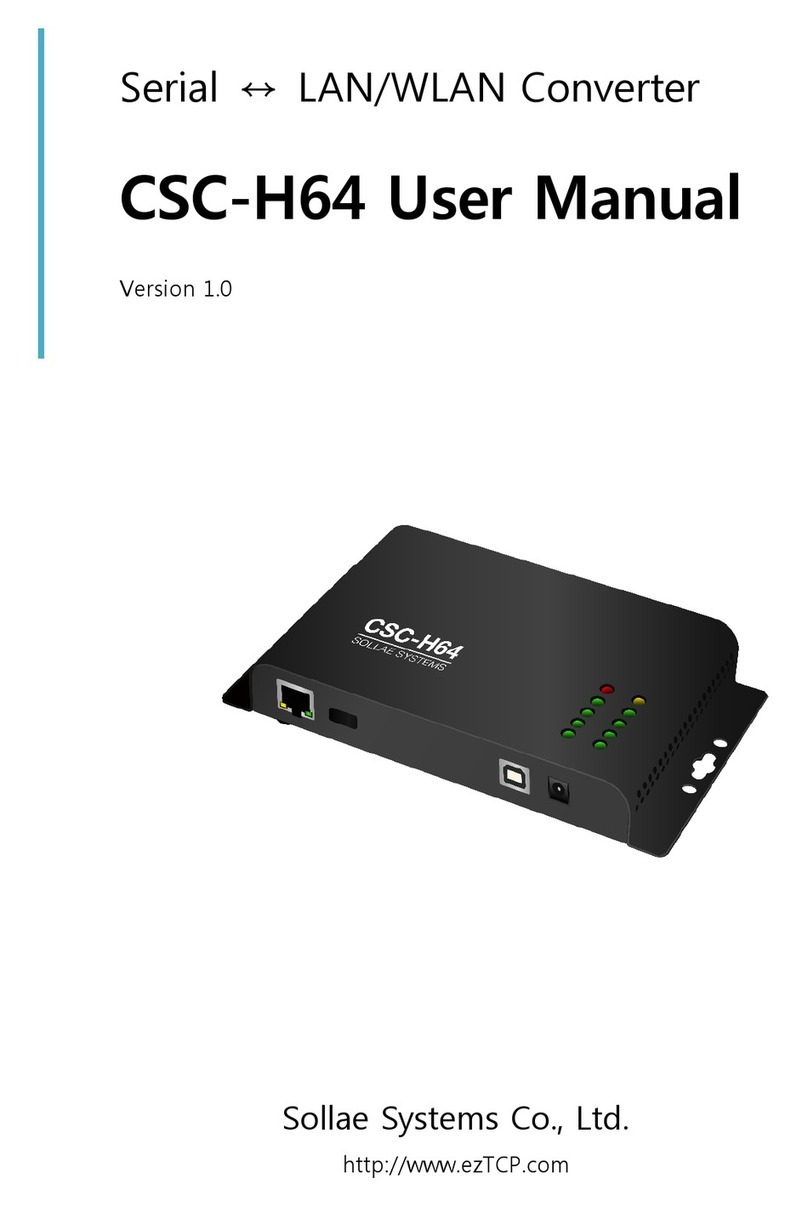
Sollae Systems
Sollae Systems CSC-H64 user manual

Expert
Expert EX-9543 user manual
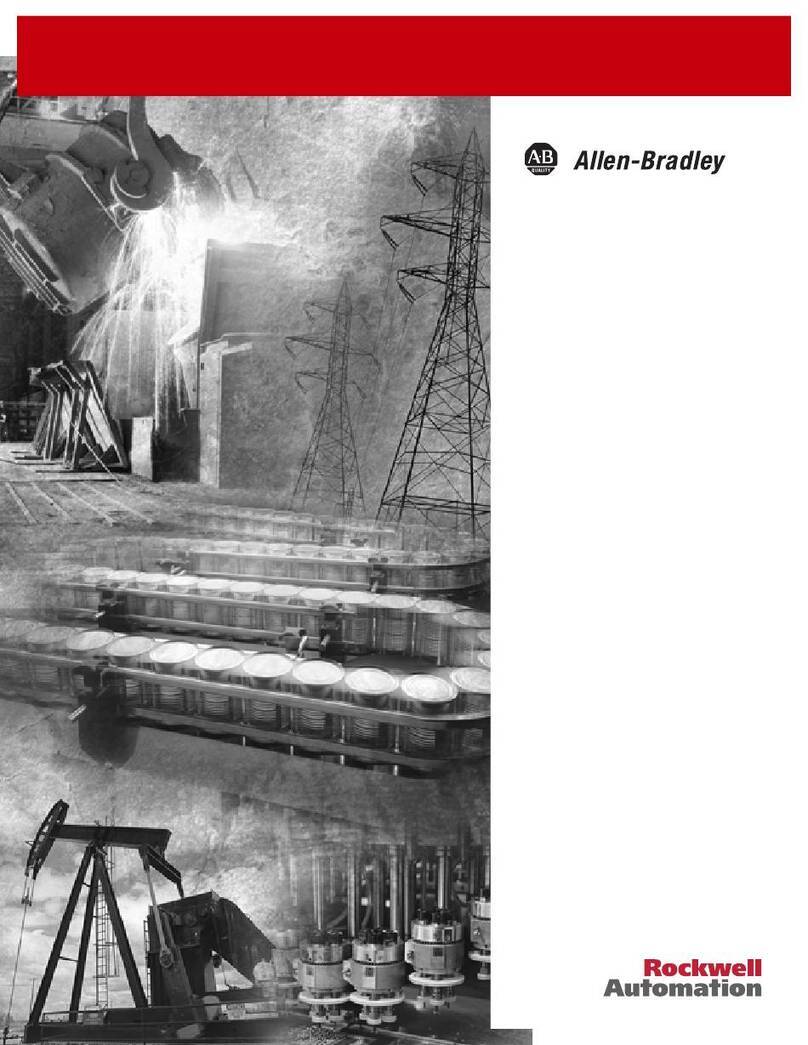
Rockwell Automation
Rockwell Automation Allen-Bradley ALEC 4100-5.3 Installation and setup manual
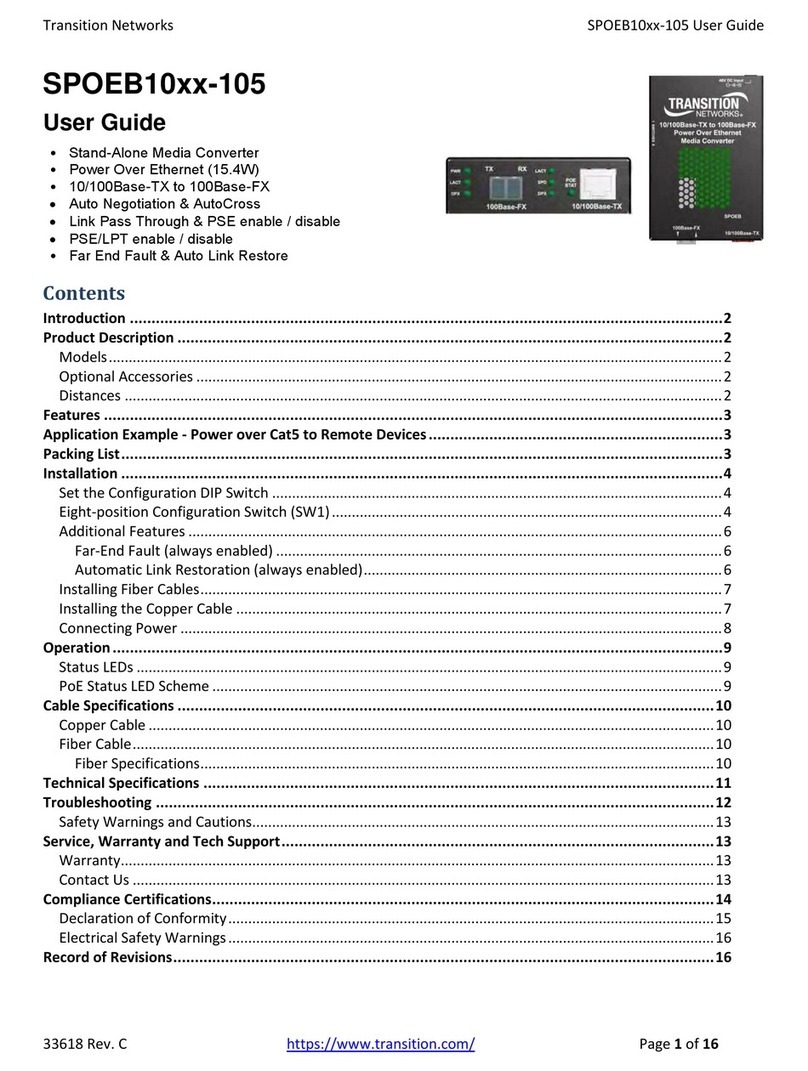
Transition Networks
Transition Networks SPOEB10 105 Series user guide
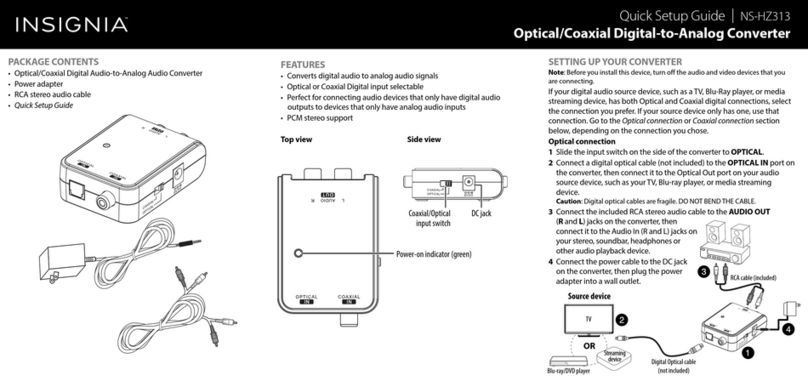
Insignia
Insignia NS-HZ313 Quick setup guide
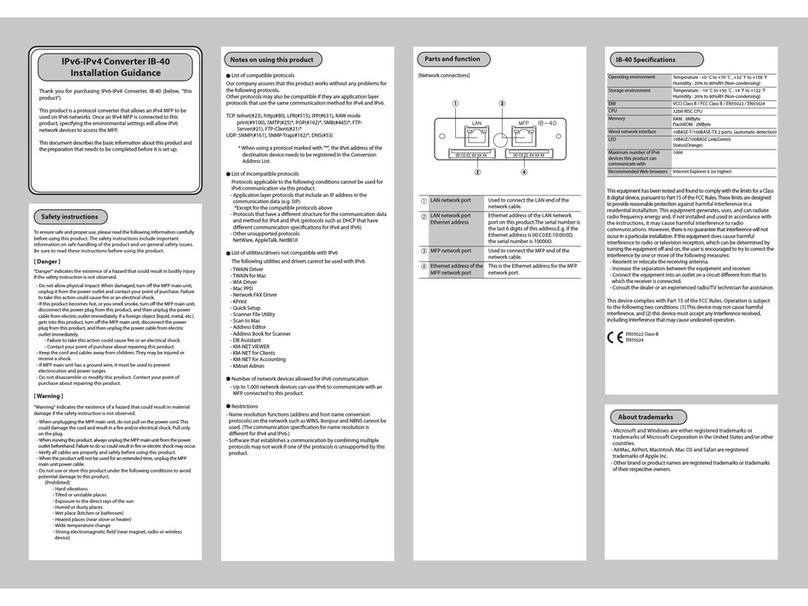
Kyocera
Kyocera KM-2560 Installation guidance
